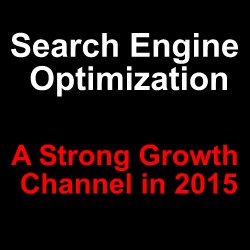Organic Search – Shows Strong Growth
 Organic Search – Shows Strong Growth
Organic Search – Shows Strong Growth
Being found in the organic search results without too much difficulty has always been good for business. A recent report by Search Engine Watch shows that search engine optimization was a very strong channel for growth in 2014.
The reason is two-fold.
1. When people search for something they want to find it and block out distractions.
2. Once these active seekers find what they want they convert at a higher rate than people bombarded by ads. Conversion is vital for online success.
The study covered more than 50 brands and 1.1 billion natural search visits in 2014.
Summary of Findings:
The average SEO-engaged brand saw its organic traffic rise by 19.8 percent year-over-year in 2014.
Paid search traffic (PPC) grew at a healthy but lower 9 percent rate year over year.
Organic search drove 21 percent of total site traffic in 2014, well up from 18.1 percent in 2013.
Not only does this show a pretty sharp rise in organic search growth in 2014 compared to other channels, but it is also helpful to know what share of your site’s traffic should be coming from natural search (as a minimum).
Natural Search Is a Tremendous Growth Channel
The study shows that there are differences depending on the vertical and kind of website. Financial and insurance brands saw lower growth than other verticals – closer to Pay-Per-Click (PPC) growth. Pharmaceuticals and health care, on the other hand, exceeded 70 percent year-over-year traffic growth in the organic search area. This should come as no surprise given all the news and controversy in this area. People are clearly using search to find solutions.
Even with the industry variations one thing is very clear. The volume of traffic from organic search is not slowing down, and in nearly every case is growing faster than other digital marketing channels.
Now let’s talk a bit about conversions. This is when a visitor to your site does what you want them to do. They subscribe to your blog, fill out a form, open an account or make a purchase. Conversions from organic search were up an impressive 27 percent compared to 2013 according to the report.
Growth was especially strong for e-commerce websites, with an average organic conversion growth rate above 40 percent.
This is a very good sign for retail marketers in 2015. It shows that consumer confidence and purchasing power are back on the rise. It also indicates that people feel very comfortable making purchases online.
When one isolates the traffic from organic search the overall conversion rates for organic search were shown to be 50 percent higher than for sites as a whole.
Organic search isn’t just showing an increase in traffic. The organic traffic tends to be qualified traffic. Qualified traffic tends to convert at a higher rate and therefore provides more value than other channels and tactics.
What It Means for 2015
First, the obvious: Brands need to engage in organic SEO. The businesses that rely only on PPC (paid search) will be missing out on a tremendous source of qualified visits. The searchers defined on the organic side of search are often in a mood to consume your content and purchase your products. Businesses need to create content that people desire and to build links into this content for high performance search positioning.
Brands who are actively working to improve their organic search position will be developing a deep well of growth potential as we move into 2015.
The Search Engines – What They Want To See
Design for Mobility
The search engines know that people are on the go and now do a significant amount of their searching using a mobile device of some type. The split between desktop visits and mobile device visits is approaching 50-50. This means that a website needs to be responsive in order not to suffer a search engine penalty.
Google has also promised more changes based on how well a website handles a visitor using a mobile device. Initial statements from Google suggests that they may boost sites that have a good mobile experience and punish the rankings of those that don’t.
Provide Genuine Answers to Problems
Search engines themselves are changing. They want to provide answers rather than a list of websites that might have an answer. Just think about how often you use a search engine when you have a specific problem you are trying to solve. I do this all the time. I need an answer to a question so I type the question into Google. Most of the time I find what I am looking for in the top 3 results. It means that the search engines are getting very good at providing “answers”.
Those direct answers and deeper insights are becoming richer, more frequent, and are swallowing up search position real estate previously owned by both paid and organic search.
Google and Bing are becoming apps rather than search engines, and making your site the answer to customers’ questions will take more than typical SEO tactics. To have more text so that Google and Bing can understand the semantics of your content will be necessary. You will need to work to make your content richer and deeper. To make your content more Google Hummingbird-friendly will determine how well you thrive in the new world that Google and the search engines have planned for us.
Staying ahead of search engine requirements and making sure that you delight your search engine visitors will drive even bigger results for you in 2015.
Here is another post that will provide you with some special insights into how to produce content that helps to provide answers to problems and how this will help your position in the organic search results. I consider it a “must-read”.
